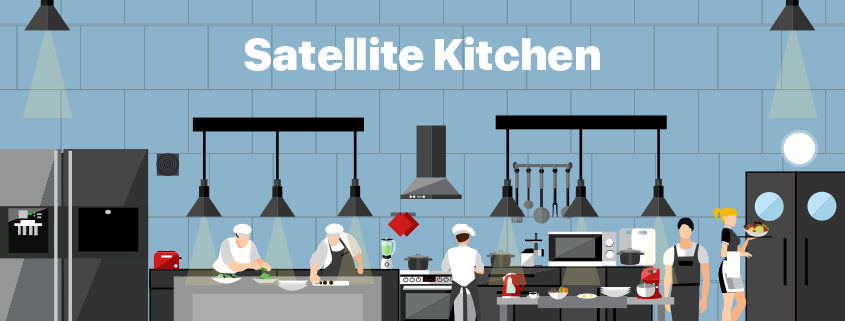Click Here to get 10% off the entire order or use the Code before Checkout "WORLDREVIEWZONE"
Main kitchens prepare and cook food, while satellite kitchens serve and distribute meals. Both play crucial roles in food service operations.
Main kitchens are the heart of food preparation in large establishments. They handle bulk cooking, ensuring consistent quality. Satellite kitchens, often located in different areas, receive and distribute meals prepared in the main kitchen. This setup is efficient for serving food in large venues like hospitals, hotels, and schools.
Satellite kitchens help maintain food temperature and quality by reducing transportation time. Both types of kitchens work together to streamline operations, maintain hygiene standards, and meet customer demands effectively. Understanding their distinct roles enhances the efficiency and quality of food service in various settings.
Main Kitchen Basics
The main kitchen is the heart of any foodservice establishment. Understanding its basics is essential for efficient operations. It serves as the primary hub where all culinary activities take place. Let's explore the core aspects of the main kitchen.
Definition And Purpose
The main kitchen is the central area for food preparation and cooking. Its primary purpose is to produce meals for immediate service or distribution. This kitchen handles everything from ingredient storage to final plating.
Main kitchens are designed to accommodate various cooking techniques and equipment. They ensure smooth workflow and maintain food quality and safety standards.
Typical Layout
A well-organized main kitchen features distinct areas for different tasks. Here's a typical layout:
| Area | Function |
|---|---|
| Preparation Area | Chopping, slicing, and other prep work |
| Cooking Area | Stoves, ovens, and grills for cooking |
| Storage Area | Refrigerators, freezers, and dry storage |
| Cleaning Area | Dishwashing and sanitizing |
Main kitchens also include specialized zones like baking, roasting, and frying. These areas ensure efficient and safe food preparation.
Essential equipment in a main kitchen includes:
- Stoves and ovens for cooking
- Refrigerators and freezers for storage
- Prep tables for ingredient preparation
- Dishwashers for cleaning
Efficient layout and equipment placement boost productivity and maintain hygiene standards in the main kitchen.
Democratizing Beauty, Nailing Affordability!
Click Here to get 15% off the entire order or use the Code before Checkout "WORLDREVIEWZONE"
Satellite Kitchen Essentials
Understanding the essentials of a satellite kitchen is crucial. A satellite kitchen supports the main kitchen by handling overflow or serving specific needs. This guide explores the key elements every satellite kitchen should have.
Role And Function
A satellite kitchen serves as an extension of the main kitchen. Its primary role is to handle additional food preparation and cooking. Satellite kitchens often serve specific areas or events, ensuring smooth and efficient service.
They are ideal for large venues, such as hotels, hospitals, or large restaurants. A satellite kitchen can also specialize in certain types of cuisine or dietary needs.
Common Setup
The setup of a satellite kitchen depends on its role. Space efficiency is crucial, so each element must be carefully planned.
Here are common components found in a satellite kitchen:
- Refrigeration Units: For storing ingredients and prepared items.
- Cooking Equipment: Such as ovens, stoves, and microwaves.
- Prep Stations: For chopping, mixing, and assembling dishes.
- Storage Solutions: Including shelves and cabinets for utensils and supplies.
- Dishwashing Area: To clean and sanitize dishes and equipment.
Below is a table summarizing the common setups:
| Component | Description |
|---|---|
| Refrigeration Units | Store ingredients and prepared items |
| Cooking Equipment | Ovens, stoves, and microwaves for cooking |
| Prep Stations | Chopping, mixing, assembling dishes |
| Storage Solutions | Shelves, cabinets for utensils and supplies |
| Dishwashing Area | Clean and sanitize dishes and equipment |
Key Differences
The main kitchen and satellite kitchen serve different purposes within a culinary setup. Understanding their key differences helps in better planning and execution of food services.
Location And Size
The main kitchen is typically located at the heart of the operation. It is often large and houses the primary cooking activities. On the other hand, a satellite kitchen is usually situated away from the main kitchen. It can be located in different buildings or floors. Satellite kitchens are generally smaller and serve specific areas.
Equipment And Resources
Main kitchens are equipped with a wide range of cooking appliances. They have large ovens, multiple burners, and industrial mixers. In contrast, satellite kitchens have limited equipment. They usually contain basic cooking tools and smaller appliances. Main kitchens have a vast array of resources and ingredients. Satellite kitchens have fewer supplies and rely on the main kitchen for refills.
| Aspect | Main Kitchen | Satellite Kitchen |
|---|---|---|
| Location | Centralized | Decentralized |
| Size | Large | Small |
| Equipment | Comprehensive | Basic |
| Resources | Extensive | Limited |
Operational Workflow
The operational workflow is crucial in both main and satellite kitchens. Understanding the differences helps optimize efficiency and service quality. Let's explore how these workflows differ in various aspects.
Food Preparation
In a main kitchen, chefs prepare food from scratch. They handle everything from cutting vegetables to cooking entrees. The main kitchen has all the tools and ingredients needed. This setup allows for a more diverse menu.
On the other hand, a satellite kitchen often receives pre-cooked or semi-prepared food. These kitchens focus on the final touches, like heating or plating. Satellite kitchens rely on the main kitchen for supplies. This setup makes them quicker but limits menu variety.
Service And Delivery
Main kitchens usually serve food directly to customers. They are often part of the main restaurant area. The service is quick, and customer feedback is immediate. Main kitchens have the advantage of direct interaction with patrons.
In contrast, satellite kitchens serve as extension points. They deliver food to different locations, often using transportation services. Satellite kitchens are common in large facilities like hotels or hospitals. They help cover more ground but may face service delays.
Here is a table summarizing the key differences:
| Aspect | Main Kitchen | Satellite Kitchen |
|---|---|---|
| Food Preparation | From scratch | Pre-cooked or semi-prepared |
| Service | Direct to customers | Via transportation |
| Menu Variety | Diverse | Limited |
Staffing Variations
The staffing variations between a main kitchen and a satellite kitchen are crucial. Understanding these differences can help optimize operations and improve efficiency. Let's explore the key distinctions in team structure and skill requirements.
Team Structure
In a main kitchen, the team structure is usually more complex. You will often find a head chef, sous chefs, line cooks, and other specialized roles.
- Head Chef: Leads the kitchen, makes menus, and oversees quality.
- Sous Chefs: Assist the head chef and manage daily operations.
- Line Cooks: Prepare specific dishes as per the head chef's guidance.
- Pastry Chefs: Specialize in baking and desserts.
In a satellite kitchen, the team is usually smaller and less specialized. The roles are more generalized due to the limited scope of operations.
- Cook: Prepares and assembles meals delivered from the main kitchen.
- Kitchen Assistant: Helps with basic tasks and cleanup.
Skill Requirements
The skill requirements for a main kitchen are generally higher. Chefs here need specialized training and extensive experience.
- Advanced cooking techniques
- Menu planning and recipe development
- Food safety and hygiene
- Team management skills
In a satellite kitchen, the skill requirements are less stringent. The focus is more on efficiency and basic cooking skills.
- Basic cooking techniques
- Food assembly and portioning
- Basic food safety
- Time management

Menu Planning
Menu planning plays a crucial role in the success of both main and satellite kitchens. It ensures the right balance between variety, quality, and customer satisfaction. Understanding the differences in menu planning for these two types of kitchens can help optimize operations and meet customer expectations more effectively.
Range Of Dishes
In a main kitchen, chefs can offer a wider range of dishes. They have access to more ingredients and can experiment with complex recipes. This allows for a diverse menu that caters to various tastes and dietary needs.
On the other hand, a satellite kitchen usually has a more limited range. These kitchens often focus on specific cuisines or types of dishes. This helps in maintaining consistency and quality across different locations.
| Kitchen Type | Range of Dishes |
|---|---|
| Main Kitchen | Wide variety, complex recipes |
| Satellite Kitchen | Limited variety, specific cuisines |
Customization And Flexibility
Customization is a strong point of main kitchens. Chefs can easily adjust ingredients and cooking methods to meet customer requests. This flexibility allows for a more personalized dining experience.
In contrast, satellite kitchens have less flexibility. They often follow standardized recipes to ensure consistency. This makes it challenging to accommodate special requests and dietary restrictions.
Here are some key points:
- Main Kitchens: High customization, flexible menu
- Satellite Kitchens: Standardized recipes, limited customization
Cost Implications
Understanding the cost implications of a main kitchen versus a satellite kitchen is crucial. It helps in making informed decisions for your business. Here's a breakdown of the initial investment and operating expenses for both types of kitchens.
Initial Investment
The initial investment differs significantly between a main kitchen and a satellite kitchen. A main kitchen generally requires a larger initial investment. This is because it needs to be equipped with all the necessary appliances, storage, and cooking spaces.
- Appliances: Ovens, stoves, refrigerators, and dishwashers.
- Storage: Walk-in coolers, freezers, and dry storage.
- Cooking Spaces: Multiple stations for different types of cuisine.
In contrast, a satellite kitchen often requires less upfront investment. It primarily needs reheating and assembly equipment.
- Reheating Equipment: Microwaves and convection ovens.
- Assembly Areas: Smaller prep spaces and minimal cooking stations.
Operating Expenses
Operating expenses are another critical factor to consider. Main kitchens usually have higher operating costs. This is due to the need for more staff, higher utility bills, and more extensive maintenance.
| Expense Type | Main Kitchen | Satellite Kitchen |
|---|---|---|
| Staff Salaries | Higher | Lower |
| Utility Bills | Higher | Lower |
| Maintenance | Extensive | Minimal |
Satellite kitchens have lower operating expenses. They need fewer staff, consume less energy, and have reduced maintenance costs.
- Fewer Staff: Reduced labor costs.
- Lower Energy Consumption: Smaller footprint and less equipment.
- Minimal Maintenance: Simpler equipment and fewer breakdowns.
Benefits And Challenges
Understanding the differences between Main Kitchens and Satellite Kitchens can help in making informed decisions. Both have unique benefits and challenges, impacting efficiency, cost, and service quality.
Advantages Of Main Kitchens
Main kitchens serve as the primary hub for culinary activities. They offer several advantages:
- Centralized Operations: Everything happens in one place, making coordination easy.
- Cost Efficiency: Bulk purchasing reduces ingredient costs.
- Quality Control: Direct oversight ensures consistent food quality.
- Advanced Equipment: Main kitchens usually have high-end equipment.
- Skilled Staff: Experienced chefs and staff work in the main kitchen.
The centralized nature of main kitchens makes them ideal for large-scale operations. They excel in maintaining high standards and reducing wastage.
Pros And Cons Of Satellite Kitchens
Satellite kitchens are smaller, decentralized units. They bring their own set of pros and cons:
| Pros | Cons |
|---|---|
|
|
While satellite kitchens offer flexibility and faster service, they also present challenges. Managing multiple locations can be complex and costly.
Frequently Asked Questions
What Is The Difference Between a Satellite Kitchen And a Central Kitchen?
A satellite kitchen reheats and serves food from a central kitchen. A central kitchen prepares and distributes meals to satellite kitchens.
What Are The Two Different Explanation For Satellite Kitchen?
Satellite kitchens serve as secondary cooking areas. They support the main kitchens in large establishments. They also refer to kitchens in remote locations, serving food prepared elsewhere.
What Are The Three Main Types Of kitchens?
The three main types of kitchens are U-shaped, L-shaped, and galley kitchens. Each design suits different spaces and needs.
What Are The Different Types Of Kitchens In Hotels?
Hotels typically feature various kitchen types: main kitchen, satellite kitchen, banquet kitchen, room service kitchen, and pastry kitchen. Each serves specific culinary needs.
Conclusion
Main kitchens serve as the central hub for food preparation, while satellite kitchens extend services to various locations. Understanding their differences helps optimize efficiency and quality in food service operations. Both types play crucial roles in meeting diverse culinary demands.
Choose the right kitchen setup to enhance your business's performance and customer satisfaction.








































































